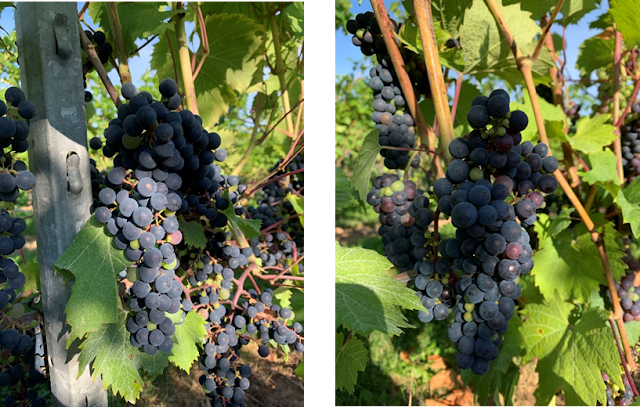Veraison is moving forward throughout the province, with the earliest hybrids starting a couple of weeks ago and now moving to the earliest Vitis vinifera varieties. With the beginning of veraison, grapes will start to change color, soften, accumulate sugar, decrease acids and other activities are moving along. Tissue sampling for nutritional purposes is one of them, start the protection of the vineyard with nets, kites and fences, and preparing to grape sampling to monitor the fruit ripening.
The beginning of
veraison will depend on the variety and the location of the vineyard, that’s
why is important to keep an eye on what’s going on with your plants. Usually, the
beginning of veraison is quite easy to distinguish in red grapes, while in white
ones it might be more difficult (depending on each case), but usually they will
get softer and translucid. If you’re unsure if these changes have started or
you already have veraison, touch the berries to feel the change of consistency,
passing from hard berries to softener ones. Even though Vitis vinifera
are behind compared hybrids, it’s possible to find in more than a couple of
places grapevines in progress with already 50% of veraison. For example,
Chardonnay, depending where is located, it’s already at 50%, while Riesling is
moving along.
Figure 1. On the left Castel and on the right Lucie
Kuhlmann.
Figure 2. On the left
L’Acadie and on the right Seyval.
Figure 3. On the left Chardonnay
and on the right Pinot noir.
Mentioned last week, with the
arrival of veraison, it’s a good time for tissue analysis for nutritional
purposes! Here some information to keep in mind at the time to proceed with the
sampling.
How to proceed with this? Please, look at the following video and fact sheet Grape Tissue Sampling to
have more information on how to proceed.
What is the role of the nutrients? You can read a section at
the Grape
Production guide to get insights about nutrients in grapevines. Please
start from page 33 with the Grape Tissue Sampling process.
When grapes start to ripe sugar
accumulation increases, acidity decreases, berries turn colorful, aromas become
stronger, and animals start to see them more appetible. Therefore, it’s important
to keep attention in your vineyard when the fruit start to ripe, to start the
installation of nets, wailers, canons, kites, barriers for raccoons, etc.
Figure 4. On the left a wailer and on the right nets
in Frontenac.
Last, the Best Practices session 4 will be this Thursday September
1 at 6:30 pm on Zoom. Registration is required, please see the following link or try the hyperlink: https://perennia.zoom.us/webinar/register/WN_q0teGWOPROi5Fwrkp_NoEA
This session’s agenda will be as follows:
- Francisco Diez: Weather update, preparing for harvest and grape sampling
- Growers’ discussions: Steve Ells from Ellslea Farm and Danielle Graham from Benjamin Bridge






.jpg)